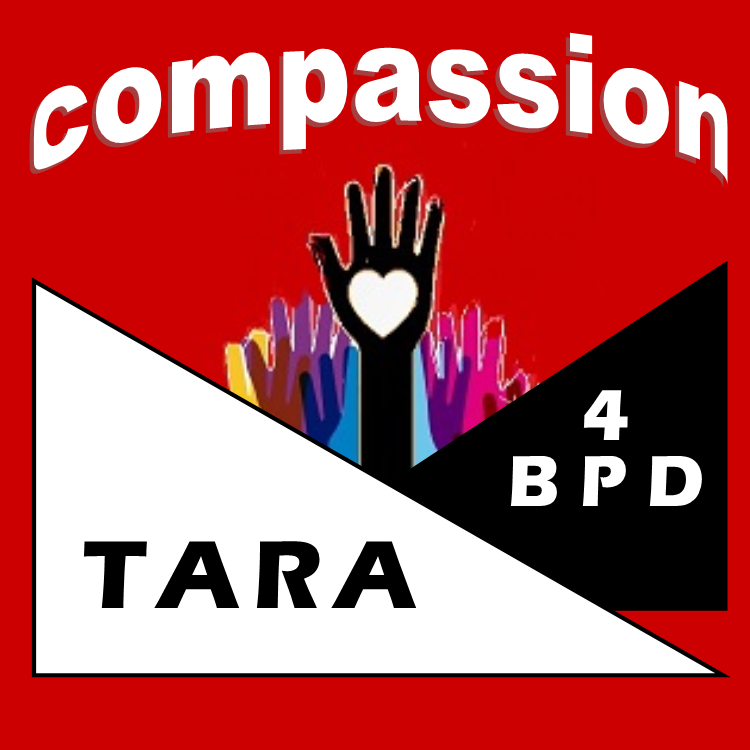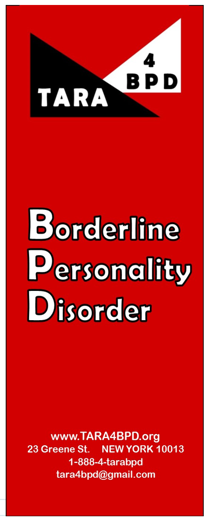What is
Borderline Personality Disorder?
BPD is often misunderstood, misdiagnosed and stigmatized. We at TARA try to provide you with the latest evidence based research results and explanations, referrals to evidence- based treatment, and statistical information regarding the effects of BPD on social issues of public health such as addiction, alcoholism, suicide, domestic violence, gambling, and incarceration. We provide you with links to current research and explanations of Dialectical Behavior Therapy (DBT), Mentalization Based Treatment (MBT), Compassion Focused Therapy (CFT), and Transference Focused Psychotherapy (TFP).
Understanding the complex neuro circuitry within the brain and how these circuits contribute to how we perceive the world will help you understand BPD so that you can anticipate triggers avoid emotional escalations, and develop much needed compassion for the pain people with BPD experience.
WHAT IS PERSONALITY DISOPRDER?
Personality: Individual differences in characteristics patterns of thinking, feeling and behaving affecting relationships to others.
Personality Disorder: Inflexible rigid, patterns of thinking, functioning and behaving. The person has trouble perceiving and relating to situations and people, is not able to deal with people or problems constructively, to adapt to changing demands of the environment. These traits can significantly impair a person’s ability to function
BORDERLINE PERSONALITY DISORDER
A genetically based severe and chronic mental illness characterized by persistent emotional instability, rapid mood changes, problems sustaining relationships, uncertain self-image, impulsive behaviors, self-injurious behaviors, and frequent suicide threats or attempts. Emotions are experienced intensely and they are often extremely sensitive to sensory stimuli such as light, sound, textures, smell, taste. Maladaptive methods are generally used to cope with constant emotional pain. BPD is diagnosable in children and adolescents.
BPD is a severe and chronic mental illness affecting 5.9 % of the population, 11% of the outpatients and 20% of inpatients. One in ten people with the disorder commits suicide, usually due to impulsivity rather than chronic depression. BPD worsens the outcome and complicates the treatment of any co-occurring disorder such as Bipolar Disorder, Substance Abuse or Eating Disorders. BPD, a major public health burden, is a key factor in substance abuse recidivism (67% of SA meet criteria for BPD), domestic violence, (22-35% of DV perpetrators meet criteria for BPD), gambling, eating disorders (40%), shop lifting, sex addiction, AIDS, homelessness and child abuse.
Impulsive aggression, a core symptom of BPD, leads a significant number of sufferers, particularly men, into fights, perpetration of domestic violence or road rage and ultimately into forensic rather than mental health settings. Relationships with people with BPD can be extremely chaotic due to their "emotional storms." They are highly sensitive to rejection and, not surprisingly, account for one out of three stalkers. Many are recipients of SSI and/or SSD. Availability of evidence based treatment nationwide remains minimal or non-existent, as are help, support or psycho-education for family members of people with BPD.
Latest research documents that patients with BPD are the most extensive users of Mental Health Services including virtually every mode of psychosocial treatment, more often and in greater amounts than any other diagnostic group. BPD patients have more complicated and impairing symptoms, more enduring distress and disability, more extensive treatment histories, a relatively higher incidence of psychiatric hospitalization and an extensive, if erratic, use of outpatient mental health services than do patients with major depression. They continue to function at lower levels despite receiving greater amounts of treatment than depressed patients. Evidence that these patients receive adequate or appropriate treatment in the community is unavailable. Functional impairment of people with BPD exceeds that of patients with major depressive disorder yet the costs to patients, families and society from BPD are persistently overlooked.
WHAT IS BORDERLINE PERSONALITY DISORDER?
BPD is a disorder in which a person is unable to regulate emotions or control impulses. Their behavior can be seen as maladaptive methods of coping with constant emotional pain. The DSM IV, which is a manual used by psychiatrists to diagnose all mental disorders, describes BPD as an AXIS 11 disorder of impulsivity and emotional dysregulation including at least five of the following (See Gray Box Below):
HOW COMMON IS BPD?
BPD is estimated to affect 2-3% of the general population, 11% of the patients seen in outpatient clinics and as many as 20% of the hospitalized psychiatric patients (inpatients). About 8-10% of people with this disorder die by suicide. BPD worsens the outcome and complicates the treatment of any other co?occurring (comorbid) disorder such as Major Depression, Bipolar Disorder (Manic Depression), Eating Disorders and Substance Abuse. BPD, difficult to diagnose, is often misdiagnosed as schizotypal or schizo-affective disorder, depression, bipolar disorder or anti-social personality disorder.
BPD plays a major role in many issues of public health such as substance abuse, domestic violence, gambling shop lifting, sex addiction, AIDS, homelessness, child abuse, and adult and adolescent suicides. A significant number of people with BPD can be found in forensic settings (such as prisons or jails). Those with BPD are heavy users of mental health services because of frequent hospitalizations and emergency room visits due to suicide attempts. Persons with BPD are difficult to treat, frustrate clinicians and are the "Grand Repeaters" in the mental health system.
CHARACTERISTICS OF BORDERLINE
Frantic efforts to avoid abandonment, going in extremes to keep someone from leaving (In extremes, "stalking")
Frequent interpersonal conflict, unstable, stormy relationships. Black-White thinking. Difficulty seeing the gray in situations or compromising.
Unstable self image, shifting from feeling confident about who you are to feeling like you are evil or don't exist.
Self-damaging, impulsive behavior such as substance abuse, binge eating, anorexia-bulimia, reckless spending, gambling, reckless driving (road rage) or behaviors that can lead to serious consequences.
Frequent suicidal thoughts, threats or attempts, or self hurting, self-mutilating behavior such as cutting or burning.
Intense emotional instability, rapid changing short term moods and anxiety.
Chronic feelings of emptiness, sadness, or depression.
Intense inappropriate anger that may lead to physical fights or destruction of property (e.g. domestic violence).
Stress related dissociative symptoms such as paranoia; feeling as though they are losing touch with reality; feeling victimized; unable to accept responsibility.
BPD is extremely painful to the patients, to those who live with them and to society. People with BPD experience emotions intensely and are very vulnerable. They are among the most intensive and extensive utilizers of mental health services.
WHY DO SOME PEOPLE DEVELOP BPD?
Latest research indicates that BPD is a biologically based disorder of the emotional regulation system which may be due to genetic, the environment or a combination of these two factors. These biological "vulnerabilities" may place a person at increased risk for developing BPD given certain developmental factors such as prenatal stresses, infections, nutritional deficits or stressful events in the early family environment Other family members may often have BPD, Major Depression, Bipolar Illness, or problems with addiction.
Serotonin, a chemical messenger (neurotransmitter) in the brain, is important in regulating mood and aggressive, impulsive, and suicidal behavior. Abnormal brain serotonin function appears to be related to a diminished ability to control one's impulses and to a heightened risk for attempting suicide.
Dopamine, a neurotransmitter in the brain, is involved in regulating awareness of the environment and other higher information processing tasks. Abnormal brain dopamine function may be involved in difficulties in relating to other people, social isolation and sometimes in distorted perceptions of the world.
HOW IS BPD TREATED?
Medications may reduce symptoms of depression, anxiety, irritability, and paranoid thoughts. A single "one-size-fits-all" medication for BPD does not exist yet. Symptom relief can be obtained when medication is closely monitored as BPD symptoms may constantly change. Recent research studies have demonstrated the effectiveness of individual cognitive behavioral therapy along with group psychoeducation and skills training that teach emotional regulation skills, distress tolerance, improved interpersonal relationship behaviors and awareness (mindfulness). This, combined with careful medication management, may allow the patient to achieve significant progress. When taught skills to regulate their emotions and tolerate distress, people with BPD can do better. Traditional psychotherapy, a long term process, may have uncertain results.
It is imperative that the person with BPD be motivated to change life long ways of behaving and be able to tolerate uncomfortable feelings during treatment where new problem solving and communication skills are taught. Appropriate treatment methods with a proven outcome studies should be utilized.
WHY IS BPD SO STIGMATIZED?
Patients with BPD are currently the most stigmatized in the mental health system. Many clinictians will not treat BPD patients. According to Dr. Joel Dvoskin former Comm. of the New York State Office Of Mental Health, "Why would psychiatry and psychology turn so viciously against people they call mentally disordered? Apparently the greatest sin a client can commit is poor response to treatment. What is apparently so wrong about these unfortunate souls is that they have yet to demonstrate the ability to get better in response to our treatment. Thus, they don't make us feel very good. With a few notable exceptions, we have simply given up on helping people who desperately need us to do a better job of helping them"(CAMI Journal on BPD, Vol 8)
FACTS ABOUT BPD
BPD makes up at least 2% of the general population, (6 million people in North America)
BPD comprises 20% of the inpatient psychiatric population.
BPD makes up 11% of the outpatients in the mental health system.
As a comparison, BPD affects 50% more people than Alzheimer's disease and nearly as many as schizophrenia and bipolar combined (2.25%).
An estimated 10% of BPD patients die by suicide.
Approximately 20% of men who batter have BPD.
Males with BPD are often sent to jail or prison for violent outbursts resulting from a biological inability to control impulsivity.
BPD generally co-occurs with depression, an anorexia-bu1imia, and other problems resulting from impulsivity (drunk or reckless driving, gambling, sex addiction or shoplifting).
BPD patients have replaced schizophrenics in the revolving door of psychiatric treatment.
Parents of those with BPD have replaced the "schizophrenogenic mothers" and the "ice-box mothers'' of autistic children as the family group who are now blamed for a psychiatric illness.
Treatment is available. It should include carefully monitored psycho-pharmacology for symptom reduction and cognitive behavioral therapy including psychoeducation and skills training.
WHAT FAMILIES CAN DO TO HELP
Recognizing signs and symptoms is not always easy. Sometimes symptoms can go unnoticed or are misunderstood. Persons with BPD may often be thought of as manipulative or as attention-seeking. They can sometimes "act as if" they are okay. People with BPD need validation and acknowledgement of the pain they struggle to live with as well as compassion without blame or judgments. Always take suicidal statements and threats seriously. Alert a mental health professional as soon as possible. The value of education for family members cannot be stressed enough. Families need to learn all they can about BPD so that they can advocate for appropriate treatment for their loved ones. Informed families are then better able to deal with the stigma often encountered from mental health professionals.
Join TARA4BPD and help advocate for BPD nationally.
Join TARA4BPD and help us raise funds for BPD research.
Organize a TARA4BPD affiliate in your area.


